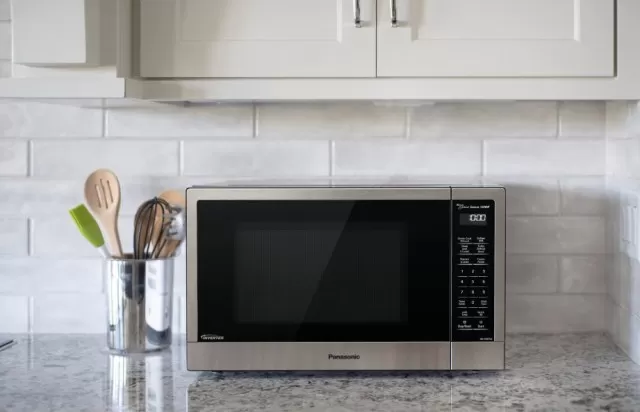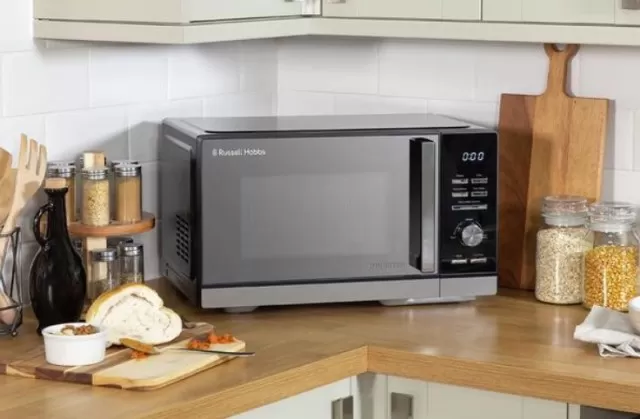In conclusion, while spray cleaners might get the job done, their chemical content raises safety concerns when used in the microwave.
The home is filled with various areas that require regular cleaning, such as floors, bathrooms, and bedrooms.
However, one often overlooked space is the inside of the microwave. It’s easy to ignore microwave messes since they are hidden once the door is closed, and guests rarely use the microwave.
Despite this, regular cleaning of microwaves is essential.
Conventional wipes or spray cleaners are the easiest and most common methods for cleaning a dirty microwave.
They are effective at removing stains and grime. However, the concern lies in the powerful chemicals present in these products.
The question arises: is it safe to use such cleaning agents in your microwave? Let’s delve into what experts have to say about this matter.
Using conventional wipes or spray cleaners inside the microwave might seem convenient, but there are potential risks to consider.
Many of these cleaning products caution against their use on surfaces that come into contact with food, like dishes and cutting boards. While microwaves may not directly touch food, residual chemical traces could still pose risks.
Registered dietitian and home economic expert, Allie Echeverria, suggests that if disinfecting products are used on food-contact surfaces, thorough rinsing with water is necessary.
Some well-known cleaning brands explicitly advise against using their products in the microwave, pointing out the challenges of proper rinsing within the enclosed space.
Furthermore, Dr. Hayley Goldbach, a board-certified dermatologist and assistant professor of Dermatology at Brown University, warns against spraying chemicals in the microwave. Although there aren’t specific studies on the absorption of these chemicals into microwaved food, it’s safer to avoid having them in an airtight space with your meal.
Additionally, certain cleaning products can impact indoor Air Quality, making their use in enclosed spaces with food less desirable.
Considering the potential risks and expert advice, it’s essential to seek alternative cleaning methods for your microwave.
Fortunately, there are safe and effective options available. One natural approach involves using water with lemon juice and peels in a microwave-safe bowl, allowing the steam to loosen stains for easy wiping.
Adding a few tablespoons of white or apple cider vinegar to the mixture can enhance the cleaning power.
Opting for safer cleaning methods, such as natural solutions, ensures a clean and safe microwave, without compromising your health or the quality of your food.
Can You Use Spray Cleaners in Your Microwave?

Using cleaning products, particularly spray cleaners, in the microwave can be a tempting solution for dealing with stubborn stains and messes.
These powerful chemicals are effective at removing dirt, grease, and grime from various surfaces in your home. While they might not directly come into contact with your food when used inside the microwave, there are potential risks and warnings to consider.
Some cleaning products caution against using them on surfaces that come into contact with food, like dishes and cutting boards.
While theoretically, using these products inside the microwave may seem safe, it’s crucial to exercise caution due to the difficulty in thoroughly rinsing the microwave’s interior.

Registered dietitian and home economic expert, Allie Echeverria, emphasizes the importance of rinsing and disinfecting products on food-contact surfaces.
Some popular cleaning brands explicitly advise against using their products in the microwave. For instance, Clorox recommends avoiding their wipes inside the microwave due to the challenge of proper rinsing.
Windex’s multi-surface cleaner is suggested for microwaves but must be rinsed with water after use.
Spraying chemicals in the microwave, as stated by Dr.Hayley Goldbach, a board-certified dermatologist and assistant professor of Dermatology at Brown University, may not be a wise choice. While there is a lack of studies specifically on the absorption of such chemicals into microwaved food, it’s best to avoid having them in an airtight space with your meal.
Certain cleaning products can also impact indoor air quality, making it less desirable to use them in an enclosed space with food, except in rare circumstances like serious contamination with dangerous food-borne illnesses.
How to Clean the Inside of Your Microwave Safely

To clean the inside of your microwave safely without using potent chemicals, there are alternative methods you can try.
One straightforward approach involves placing water in a microwave-safe bowl with lemon juice and peels. After microwaving the mixture for a few minutes, the steam will help loosen stains, making it easy to wipe down the interior with a microfiber cloth.
For added cleaning power, you can also add a few tablespoons of white or apple cider vinegar to the water and lemon mixture. This natural cleaning method is safer and can be just as effective at keeping your microwave clean and fresh.
*The information is for reference only.